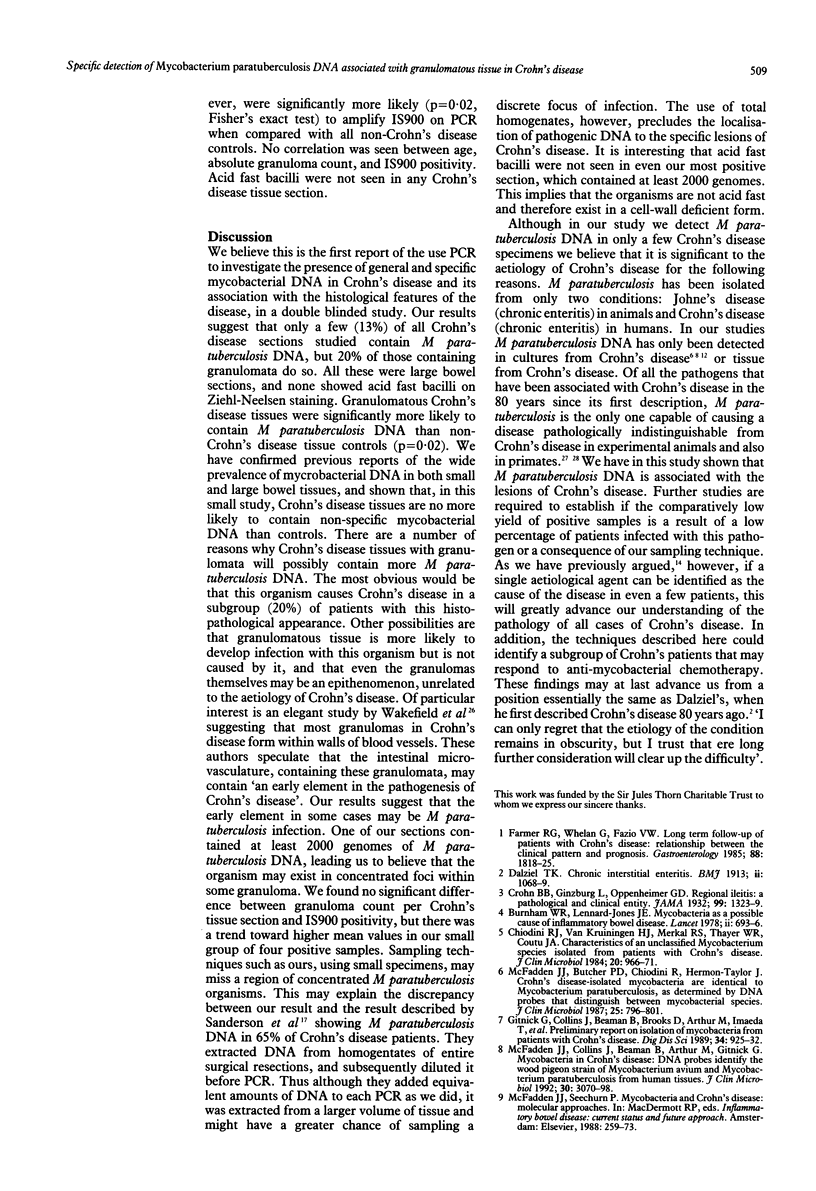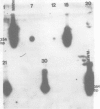Abstract
The role of mycobacteria, specifically Mycobacterium paratuberculosis, in Crohn's disease has aroused considerable controversy for many years. Using the ultra sensitive polymerase chain reaction some studies have reported detection of M paratuberculosis DNA in as many as 65% of Crohn's disease patients but also in patients without disease. Other studies have been negative for both groups. We therefore designed a double blind control trial to investigate the presence of mycobacterial DNA in age, sex, and tissue matched paraffin wax embedded tissues from 31 Crohn's disease tissues, 20 diseased gut control tissues, and 10 ulcerative colitis tissues. The specimens were coded and analysed blind with three separate polymerase chain reactions (PCR) based on DNA sequences specific for M paratuberculosis (IS900), M avium (RFLP type A/1) (IS901), and the Mycobacterium genus (65 kDa gene, TB600). The number of granulomata and presence of acid fast bacilli in each Crohn's disease tissue was also investigated. The sensitivity of the system was determined using similarly prepared gut tissue from an animal infected with M paratuberculosis. Four of 31 Crohn's disease tissues and none of the 30 control and ulcerative colitis derived tissues amplified M paratuberculosis DNA. Crohn's disease tissues containing granulomata were significantly more likely to amplify M paratuberculosis specific DNA on PCR than the non-Crohn's disease tissues (p = 0.02). All the positive Crohn's disease tissues contained granulomata, and none contained acid fast bacilli. Equivalent numbers of Crohn's and non-Crohn's disease tissues amplified the region of the 65 kD gene on PCR for non-specific mycobacterial DNA (11/31 and 9/30 respectively). No sections produced an amplified product with the IS901 PCR. These results suggest that few Crohn's disease gut biopsy sections contain M paratuberculosis DNA in association with granulomata. The absence of such DNA in any control and ulcerative colitic tissue strengthens the case for it having a specific association, which may be pathogenic, with Crohn's disease in this minority of patients.
Full text
PDF




Images in this article
Selected References
These references are in PubMed. This may not be the complete list of references from this article.
- Burnham W. R., Lennard-Jones J. E., Stanford J. L., Bird R. G. Mycobacteria as a possible cause of inflammatory bowel disease. Lancet. 1978 Sep 30;2(8092 Pt 1):693–696. doi: 10.1016/s0140-6736(78)92699-5. [DOI] [PubMed] [Google Scholar]
- Chiodini R. J. Crohn's disease and the mycobacterioses: a review and comparison of two disease entities. Clin Microbiol Rev. 1989 Jan;2(1):90–117. doi: 10.1128/cmr.2.1.90. [DOI] [PMC free article] [PubMed] [Google Scholar]
- Chiodini R. J., Van Kruiningen H. J., Thayer W. R., Coutu J. A. Spheroplastic phase of mycobacteria isolated from patients with Crohn's disease. J Clin Microbiol. 1986 Sep;24(3):357–363. doi: 10.1128/jcm.24.3.357-363.1986. [DOI] [PMC free article] [PubMed] [Google Scholar]
- Farmer R. G., Whelan G., Fazio V. W. Long-term follow-up of patients with Crohn's disease. Relationship between the clinical pattern and prognosis. Gastroenterology. 1985 Jun;88(6):1818–1825. doi: 10.1016/0016-5085(85)90006-x. [DOI] [PubMed] [Google Scholar]
- Fidler H. M., Rook G. A., Johnson N. M., McFadden J. Mycobacterium tuberculosis DNA in tissue affected by sarcoidosis. BMJ. 1993 Feb 27;306(6877):546–549. doi: 10.1136/bmj.306.6877.546. [DOI] [PMC free article] [PubMed] [Google Scholar]
- Gitnick G., Collins J., Beaman B., Brooks D., Arthur M., Imaeda T., Palieschesky M. Preliminary report on isolation of mycobacteria from patients with Crohn's disease. Dig Dis Sci. 1989 Jun;34(6):925–932. doi: 10.1007/BF01540280. [DOI] [PubMed] [Google Scholar]
- Green E. P., Tizard M. L., Moss M. T., Thompson J., Winterbourne D. J., McFadden J. J., Hermon-Taylor J. Sequence and characteristics of IS900, an insertion element identified in a human Crohn's disease isolate of Mycobacterium paratuberculosis. Nucleic Acids Res. 1989 Nov 25;17(22):9063–9073. doi: 10.1093/nar/17.22.9063. [DOI] [PMC free article] [PubMed] [Google Scholar]
- Hampson S. J., Portaels F., Thompson J., Green E. P., Moss M. T., Hermon-Taylor J., McFadden J. J. DNA probes demonstrate a single highly conserved strain of Mycobacterium avium infecting AIDS patients. Lancet. 1989 Jan 14;1(8629):65–68. doi: 10.1016/s0140-6736(89)91427-x. [DOI] [PubMed] [Google Scholar]
- Kunze Z. M., Portaels F., McFadden J. J. Biologically distinct subtypes of Mycobacterium avium differ in possession of insertion sequence IS901. J Clin Microbiol. 1992 Sep;30(9):2366–2372. doi: 10.1128/jcm.30.9.2366-2372.1992. [DOI] [PMC free article] [PubMed] [Google Scholar]
- Kunze Z. M., Wall S., Appelberg R., Silva M. T., Portaels F., McFadden J. J. IS901, a new member of a widespread class of atypical insertion sequences, is associated with pathogenicity in Mycobacterium avium. Mol Microbiol. 1991 Sep;5(9):2265–2272. doi: 10.1111/j.1365-2958.1991.tb02157.x. [DOI] [PubMed] [Google Scholar]
- McFadden J. J., Butcher P. D., Chiodini R., Hermon-Taylor J. Crohn's disease-isolated mycobacteria are identical to Mycobacterium paratuberculosis, as determined by DNA probes that distinguish between mycobacterial species. J Clin Microbiol. 1987 May;25(5):796–801. doi: 10.1128/jcm.25.5.796-801.1987. [DOI] [PMC free article] [PubMed] [Google Scholar]
- McFadden J., Collins J., Beaman B., Arthur M., Gitnick G. Mycobacteria in Crohn's disease: DNA probes identify the wood pigeon strain of Mycobacterium avium and Mycobacterium paratuberculosis from human tissue. J Clin Microbiol. 1992 Dec;30(12):3070–3073. doi: 10.1128/jcm.30.12.3070-3073.1992. [DOI] [PMC free article] [PubMed] [Google Scholar]
- Saboor S. A., Johnson N. M., McFadden J. Detection of mycobacterial DNA in sarcoidosis and tuberculosis with polymerase chain reaction. Lancet. 1992 Apr 25;339(8800):1012–1015. doi: 10.1016/0140-6736(92)90535-b. [DOI] [PubMed] [Google Scholar]
- Sanderson J. D., Moss M. T., Tizard M. L., Hermon-Taylor J. Mycobacterium paratuberculosis DNA in Crohn's disease tissue. Gut. 1992 Jul;33(7):890–896. doi: 10.1136/gut.33.7.890. [DOI] [PMC free article] [PubMed] [Google Scholar]
- Shinnick T. M. The 65-kilodalton antigen of Mycobacterium tuberculosis. J Bacteriol. 1987 Mar;169(3):1080–1088. doi: 10.1128/jb.169.3.1080-1088.1987. [DOI] [PMC free article] [PubMed] [Google Scholar]
- Vary P. H., Andersen P. R., Green E., Hermon-Taylor J., McFadden J. J. Use of highly specific DNA probes and the polymerase chain reaction to detect Mycobacterium paratuberculosis in Johne's disease. J Clin Microbiol. 1990 May;28(5):933–937. doi: 10.1128/jcm.28.5.933-937.1990. [DOI] [PMC free article] [PubMed] [Google Scholar]
- Wakefield A. J., Sankey E. A., Dhillon A. P., Sawyerr A. M., More L., Sim R., Pittilo R. M., Rowles P. M., Hudson M., Lewis A. A. Granulomatous vasculitis in Crohn's disease. Gastroenterology. 1991 May;100(5 Pt 1):1279–1287. [PubMed] [Google Scholar]
- Wall S., Kunze Z. M., Saboor S., Soufleri I., Seechurn P., Chiodini R., McFadden J. J. Identification of spheroplast-like agents isolated from tissues of patients with Crohn's disease and control tissues by polymerase chain reaction. J Clin Microbiol. 1993 May;31(5):1241–1245. doi: 10.1128/jcm.31.5.1241-1245.1993. [DOI] [PMC free article] [PubMed] [Google Scholar]
- Wu S. W., Pao C. C., Chan J., Yen T. S. Lack of mycobacterial DNA in Crohn's disease tissue. Lancet. 1991 Jan 19;337(8734):174–175. doi: 10.1016/0140-6736(91)90837-f. [DOI] [PubMed] [Google Scholar]
- Yoshimura H. H., Graham D. Y., Estes M. K., Merkal R. S. Investigation of association of mycobacteria with inflammatory bowel disease by nucleic acid hybridization. J Clin Microbiol. 1987 Jan;25(1):45–51. doi: 10.1128/jcm.25.1.45-51.1987. [DOI] [PMC free article] [PubMed] [Google Scholar]




